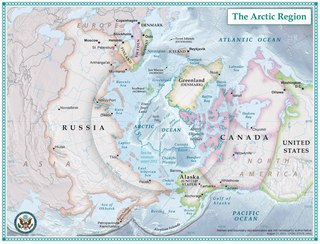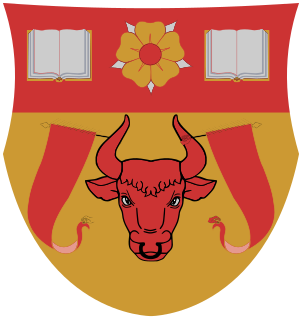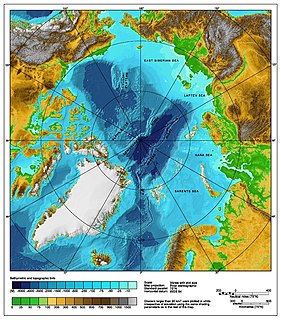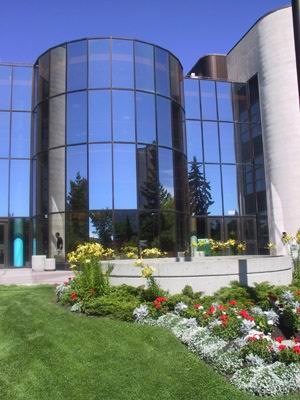
Greenland is the world's largest island, located between the Arctic and Atlantic oceans, east of the Canadian Arctic Archipelago. It is an autonomous territory within the Kingdom of Denmark. Though physiographically a part of the continent of North America, Greenland has been politically and culturally associated with Europe for more than a millennium. The majority of its residents are Inuit, whose ancestors migrated from Alaska through Northern Canada, gradually settling across the island by the 13th century.

The Arctic is a polar region located at the northernmost part of Earth. The Arctic consists of the Arctic Ocean, adjacent seas, and parts of Alaska, Finland, Greenland (Denmark), Iceland, Northern Canada, Norway, Russia, and Sweden. Land within the Arctic region has seasonally varying snow and ice cover, with predominantly treeless permafrost containing tundra. Arctic seas contain seasonal sea ice in many places.

Ellesmere Island is part of the Qikiqtaaluk Region in the Canadian territory of Nunavut. Lying within the Arctic Archipelago, it is considered part of the Queen Elizabeth Islands, with Cape Columbia being the most northerly point of land in Canada. It comprises an area of 196,235 km2 (75,767 sq mi) and the total length of the island is 830 km (520 mi), making it the world's tenth largest island and Canada's third largest island. The Arctic Cordillera mountain system covers much of Ellesmere Island, making it the most mountainous in the Arctic Archipelago. The Arctic willow is the only woody species to grow on Ellesmere Island.

The International Polar Years (IPY) are collaborative, international efforts with intensive research foci on the polar regions. Karl Weyprecht, an Austro-Hungarian naval officer, motivated the endeavor in 1875, but died before it first occurred in 1882–1883. Fifty years later (1932–1933) a second IPY took place. The International Geophysical Year was inspired by the IPY and was organized 75 years after the first IPY (1957–58). The fourth, and most recent, IPY covered two full annual cycles from March 2007 to March 2009.

The University of Calgary is a public research university located in Calgary, Alberta, Canada. The University of Calgary started in 1944 as the Calgary branch of the University of Alberta, founded in 1908, prior to being instituted into a separate, autonomous university in 1966. It is composed of 14 faculties and over 85 research institutes and centres. The main campus is located in the northwest quadrant of the city near the Bow River and a smaller south campus is located in the city center. The main campus houses most of the research facilities and works with provincial and federal research and regulatory agencies, several of which are housed next to the campus such as the Geological Survey of Canada. The main campus covers approximately 200 hectares.

The University of Tromsø – The Arctic University of Norway is the world's northernmost university. Located in the city of Tromsø, Norway, it was established in 1968, and opened in 1972. It is one of eight universities in Norway. The University of Tromsø is the largest research and educational institution in northern Norway. The University's location makes it a natural venue for the development of studies of the region's natural environment, culture, and society.
The University of the Arctic (UArctic) is an international cooperative network based in the Circumpolar Arctic region, consisting of universities, colleges, and other organizations with an interest in promoting education and research in the Arctic region.

Sheila Watt-Cloutier, OC is a Canadian Inuit activist. She has been a political representative for Inuit at the regional, national and international levels, most recently as International Chair for Inuit Circumpolar Council. Watt-Cloutier has worked on a range of social and environmental issues affecting Inuit, most recently, persistent organic pollutants and global warming. She has received numerous awards and honors for her work, and has been featured in a number of documentaries and profiled by journalists from all media. Watt-Cloutier sits as an advisor to Canada's Ecofiscal Commission. She is also a senior fellow at the Centre for International Governance Innovation.

The International Permafrost Association (IPA), founded in 1983, has as its objectives to foster the dissemination of knowledge concerning permafrost and to promote cooperation among persons and national or international organisations engaged in scientific investigation and engineering work related to permafrost and seasonally frozen ground. The IPA became an Affiliated Organisation of the International Union of Geological Sciences in July 1989.

The Arctic consists of land, internal waters, territorial seas, exclusive economic zones (EEZs) and high seas above the Arctic Circle. All land, internal waters, territorial seas and EEZs in the Arctic are under the jurisdiction of one of the eight Arctic coastal states: Canada, Norway, Russia, Denmark, Iceland, Sweden, Finland and the United States. International law regulates this area as with other portions of the Earth.

The effects of global warming in the Arctic, or climate change in the Arctic include rising air and water temperatures, loss of sea ice, and melting of the Greenland ice sheet with a related cold temperature anomaly, observed since the 1970s. Related impacts include ocean circulation changes, increased input of freshwater, and ocean acidification. Indirect effects through potential climate teleconnections to mid latitudes may result in a greater frequency of extreme weather events, ecological, biological and phenology changes, biological migrations and extinctions, natural resource stresses and as well as human health, displacement and security issues. Potential methane releases from the region, especially through the thawing of permafrost and methane clathrates, may occur. Presently, the Arctic is warming twice as fast as the rest of the world. The pronounced warming signal, the amplified response of the Arctic to global warming, is often seen as a leading indicator of global warming. The melting of Greenland's ice sheet is linked to polar amplification. According to a study published in 2016, about 0.5 °C (0.90 °F) of the warming in the Arctic has been attributed to reductions in sulfate aerosols in Europe since 1980.

The Libin Cardiovascular Institute of Alberta is a partnership between Alberta Health Services and the University of Calgary. Its mandate comprises all cardiovascular research, education and service delivery, with a service area extending from Saskatchewan, Southern Alberta and Eastern British Columbia. The Institute coordinates the activities of 1,500 individuals in Southern Alberta. Of its more than 175 research and clinician members, over 65 are cardiologists, making it the largest heart or cardiovascular institute in Western Canada by that measure.
The Ilulissat Declaration was announced on May 28, 2008 by the five coastal states of the Arctic Ocean, meeting at the political level during the Arctic Ocean Conference in Ilulissat, Greenland to discuss the Arctic ocean, climate change, the protection of the marine environment, maritime safety, and division of emergency responsibilities if new shipping routes are opened.

The Arctic Institute of North America is a multi-disciplinary research institute and educational organization located in the University of Calgary. It is mandated to study the North American and circumpolar Arctic in the areas of natural science, social science, arts and the humanities. In addition, it acquires, preserves and disseminates information on environmental, physical, and social conditions in the North. The institute was created in 1945 by a Canadian Act of Parliament as a non-profit membership organization, and also incorporated in the State of New York.
Karla Jessen Williamson is an assistant professor of educational foundations at the University of Saskatchewan. Formerly, she was the executive director of the Arctic Institute of North America (AINA), the first woman and first Inuk to hold the position. Fluent in Danish, English, and Greenlandic, she is an educator and researcher on cross-culturalism, multiculturalism, antiracism, and Aboriginal epistemology.
Mary J. May Simon, is a former Canadian diplomat and current fellow with the Arctic Institute of North America. Early in her career, she was a producer and announcer for CBC North, and later entered public service as secretary of the board for the Northern Quebec Inuit Association. Simon was Canada's first Ambassador for Circumpolar Affairs, and was a lead negotiator for the creation of the Arctic Council. She also later served as ambassador to Denmark.

Arctic cooperation and politics are partially coordinated via the Arctic Council, composed of the eight Arctic nations: the United States of America, Canada, Iceland, Norway, Sweden, Finland, Russia, and Denmark with Greenland and the Faroe Islands. The dominant governmental power in Arctic policy resides within the executive offices, legislative bodies, and implementing agencies of the eight Arctic nations, and to a lesser extent other nations, such as United Kingdom, Germany, European Union and China. NGOs and Academia play a large part in Arctic policy. Also important are intergovernmental bodies such as the United Nations and NATO.
Arctic is a quarterly, peer-reviewed, multidisciplinary, scientific journal, published by the Arctic Institute of North America. The focus of Arctic is original research articles on all topics about or related to the northern polar and sub-polar regions of the world. Additional published formats are book reviews, profiles of notable persons, specific geographic locations, notable northern events, commentaries, letters to the editor, and a general interest section consisting of essays and institute news. Mutltidisciplinary coverage encompasses physical sciences, social sciences, biological sciences, humanities, engineering, and technology. The journal was first published in spring of 1948.

The Arctic Circle is one of the two polar circles and the most northerly of the five major circles of latitude as shown on maps of Earth. It marks the northernmost point at which the centre of the noon sun is just visible on the December solstice and the southernmost point at which the centre of the midnight sun is just visible on the June solstice. The region north of this circle is known as the Arctic, and the zone just to the south is called the Northern Temperate Zone.
CircumArctic Rangifer Monitoring and Assessment Network (CARMA) is a scientific research network, launched in 2004 in Vancouver, British Columbia and funded by the Canadian IPY which focusses on the health of health "the North’s migratory tundra caribou and wild reindeer populations" in the face of global change, with up to 80% declines of some herds of wild Rangifer since 2004. The collaborative research is undertaken by an international team of scientists, administrators and members of local community members, particularly Rangifer hunters who share a common interest in their survival














